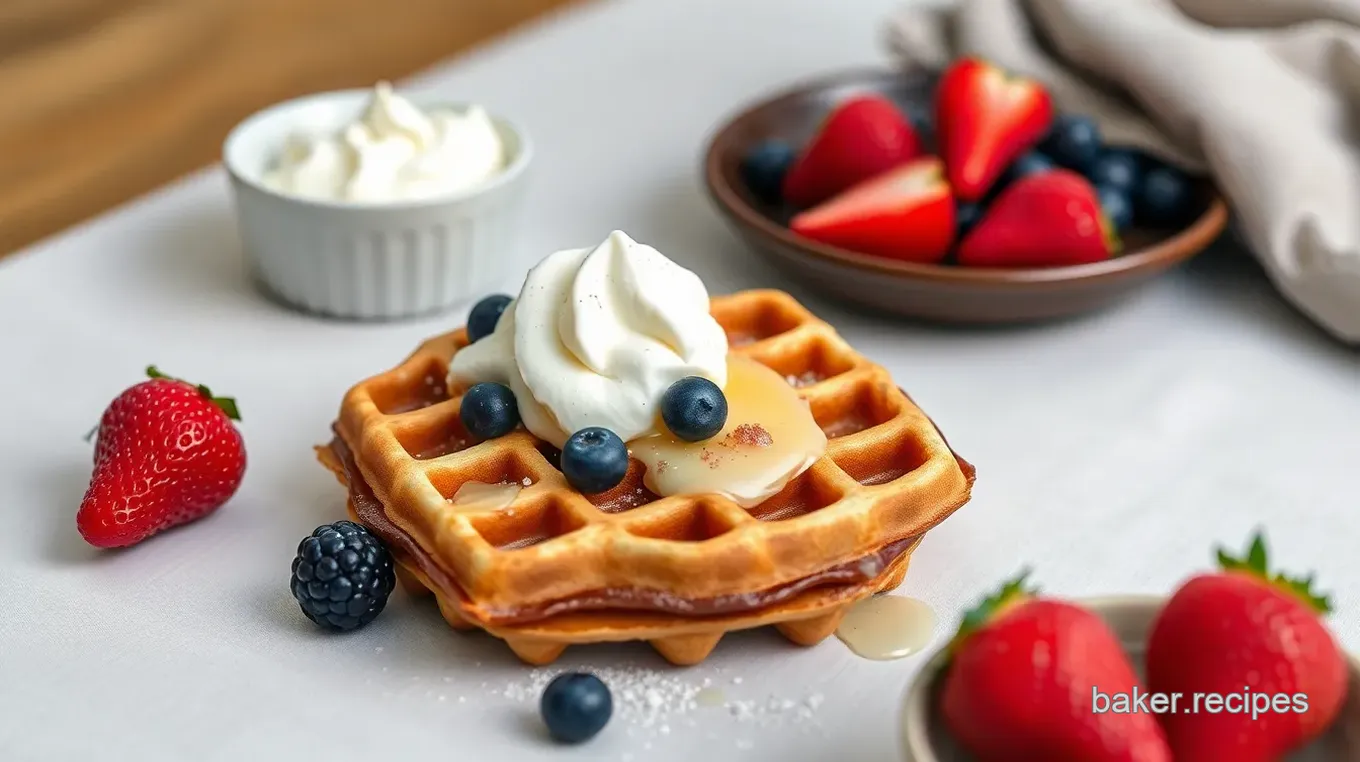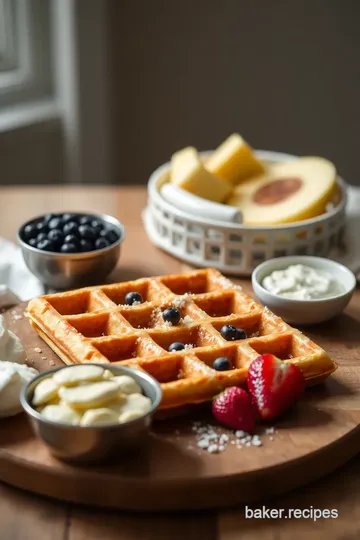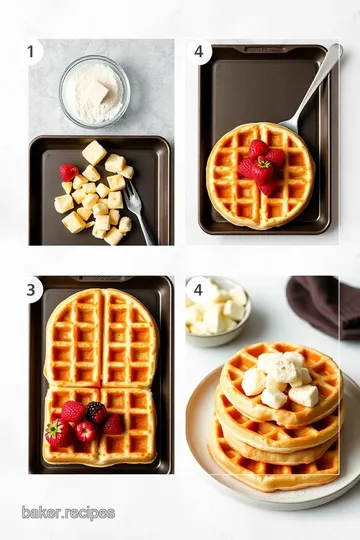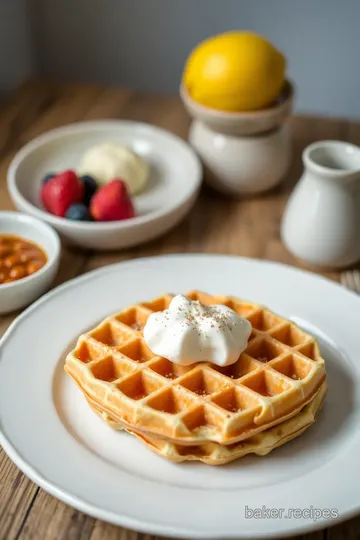Belgian Waffles Without Milk
Enjoy these Dairy-Free Belgian Waffles! In just 20 minutes, make fluffy waffles with flour, eggs, and oil. Perfect for breakfast or brunch!

- About Belgian Waffles Without Milk
- The Complete Guide to Authentic Belgian Waffles Without Milk
- Your New Favorite Belgian Waffles Without Milk
- Health & Nutrition Highlights
- Recipe at a Glance
- Quality Ingredients Breakdown
- Pro Ingredient Tips
- Professional Cooking Guide
- Success Guaranteed Tips
- Perfect Presentation
- Storage & Make-Ahead
- Creative Variations
- Expert FAQ Solutions
- Complete Nutrition Guide
- Recipe Card
About Belgian Waffles Without Milk
Belgian waffles have a rich history that dates back to the Middle Ages in Belgium. These delightful treats were originally enjoyed at local fairs and festivals. Over time, they gained popularity across Europe and eventually made their way to North America. The unique texture of Belgian waffles, known for being light and airy on the inside while crispy on the outside, makes them distinct from traditional waffles.
One of the standout features of our Belgian Waffles Without Milk recipe is its inclusivity for those with dietary restrictions. This recipe caters to lactose-intolerant individuals or anyone seeking a dairy-free option without sacrificing taste or texture. Enjoying these delicious waffles means indulging in flavor without compromise.
The Complete Guide to Authentic Belgian Waffles Without Milk
The culinary heritage surrounding Belgian waffles is both rich and engaging. Originating from Belgium's diverse regions, each area has its variations that reflect local tastes and traditions. The fascinating origin story often ties back to street vendors serving freshly made waffles topped with fruit, whipped cream, or chocolate sauces.
Culturally significant as a national dish, these waffles hold a special place in Belgian cuisine. Modern-day popularity continues to soar as people around the globe embrace this tasty breakfast staple in various forms—whether served plain or adorned with creative toppings.
Your New Favorite Belgian Waffles Without Milk
Prepare to fall in love with our Belgian Waffles Without Milk , thanks to their unique flavor combinations! You can customize your batter by adding spices like cinnamon or nutmeg for an extra kick. With foolproof techniques detailed below, even novice cooks can achieve restaurant-quality results at home.
Our expert-tested method ensures you’ll create perfectly fluffy yet crisp waffles every time! Plus, we offer time-saving tips so you can whip up a batch quickly—ideal for busy mornings or spontaneous brunch gatherings.
Health & Nutrition Highlights
These delectable Belgian Waffles Without Milk come packed with key nutritional benefits that make them suitable for various diets! Made primarily from all-purpose flour and eggs, they provide essential carbohydrates necessary for energy throughout your day while being free from dairy products.
Dietary considerations are vital; our recipe supports those who are lactose intolerant while still delivering satisfying flavors everyone can enjoy! Wellness advantages include lower cholesterol levels since there’s no milk involved—which aligns well with heart-healthy eating habits—and offers balanced nutrition facts that fit into many meal plans effectively.
Recipe at a Glance
This easy-to-follow Belgian Waffles Without Milk recipe requires only about 15 minutes of preparation time! It is perfect for both beginners looking to enhance their culinary skills and seasoned chefs wanting quick meals without compromising quality.
Each serving size yields one waffle; ideal when planning portions for family breakfasts or brunches where guests want seconds (or thirds!). Additionally, this cost-efficient recipe makes use of common pantry ingredients ensuring you won’t break the bank while enjoying Gourmet-inspired dishes right at home!
Indulge yourself today by trying out our scrumptious Belgian Waffles Without Milk —a delightful twist on classic comfort food that embraces modern dietary needs beautifully!

Quality Ingredients Breakdown
Premium Core Ingredients
To make delicious Belgian waffles without milk, it’s essential to use high-quality core ingredients. Here’s a breakdown of what you’ll need:
-
All-Purpose Flour : Measure out 2 cups for the perfect waffle base. Look for flour that is finely ground and has a consistent texture. Choose brands labeled as "unbleached" for better flavor. Store in an airtight container to keep moisture out.
-
Sugar : You will need 2 tablespoons of sugar to add just the right amount of sweetness. Opt for organic cane sugar if possible, as it usually has fewer additives. Keep sugar in a cool, dry place to maintain its quality.
-
Baking Powder : Use 1 tablespoon of baking powder , ensuring your waffles rise perfectly. Check the expiration date before using; fresh baking powder provides better leavening power. Store it tightly sealed away from humidity.
-
Salt : A pinch is vital! Use only 1/2 teaspoon of salt to enhance flavors without overpowering them. Sea salt or kosher salt are great picks due to their purity and taste.
-
Vegetable Oil or Coconut Oil : Measure out 1/4 cup , depending on your preference for flavor and health benefits. For coconut oil, choose virgin or unrefined varieties for optimal taste and aroma while storing it at room temperature.
-
Eggs : Two large eggs provide richness and structure; select farm-fresh eggs when possible for superior flavor and nutrition. Store them in their original carton in the refrigerator.
-
Water : You will need about 1 3/4 cups of water , adjust this based on batter consistency preferences.
Signature Seasoning Blend
Adding unique flavors can elevate your Belgian waffles beyond basic sweetness:
-
Consider adding spices like cinnamon—a classic pairing with breakfast dishes—for warmth (about 1 teaspoon). Nutmeg also works well—use sparingly!
-
Experiment with herbs like dried thyme or rosemary (just a pinch) if you want a savory twist on traditional sweet waffles.
-
To further enhance flavors, consider vanilla extract ( 1 teaspoon ) which adds depth—always opt for pure vanilla over synthetic versions!
Smart Substitutions
If you're missing an ingredient or require dietary modifications, here are some smart swaps:
-
Instead of all-purpose flour, try whole wheat flour or gluten-free flour blends that perform similarly but offer different health benefits.
-
For those avoiding eggs, flaxseed meal (mix 1 tablespoon with 3 tablespoons water) serves as an excellent egg substitute.
-
If vegetable oil isn’t available, melted butter can be used instead—though check if it's suitable per dietary needs.
-
In case you run short on sugar, natural sweeteners like honey or maple syrup could work well; just reduce liquid accordingly since they add more moisture than granulated sugars do.
Kitchen Equipment Essentials
Making these delightful Belgian waffles requires specific kitchen tools:
Must-Have Tools:
-
A reliable Belgian waffle maker is crucial; choose one with non-stick surfaces for easy release.
-
Mixing bowls—ideally glass or stainless steel—are best suited because they resist staining and odors.
-
A whisk helps combine ingredients smoothly while also incorporating air into batters effectively enhancing fluffiness!
Recommended Appliances:
-
An electric mixer may help if you're looking to save time whisking egg mixtures by hand!
-
Measuring cups & spoons ensure accuracy when preparing each ingredient correctly without guesswork involved!
Helpful Gadgets:
-
Silicone spatulas allow scraping every last bit from mixing bowls efficiently!
-
Tongs help remove freshly cooked waffles safely from hot irons!
Home Alternatives:
- If lacking gadgets mentioned above such as measuring cups/spoons – standard items like coffee mugs can serve similar purposes (e.g., mug=approximate cup measure).
Pro Ingredient Tips
Maximize your cooking success by following these pro tips:
Selection Secrets:
Choose organic options when available—they often contain fewer pesticides leading towards healthier meals overall!
Quality Markers:
When selecting vegetables/oils opt ones packaged visibly showcasing freshness through clear containers where applicable!
Storage Solutions:
Keep spices stored away from direct sunlight inside dark cabinets prolong shelf life significantly improving potency during cooking endeavors!
Money-Saving Tips:
Buying in bulk saves money long-term while ensuring top-notch quality ingredients ready whenever cravings strike!
Professional Cooking Guide
Essential Preparation Steps
Mise en Place Details
Start with mise en place, which means “everything in its place.” Gather all ingredients needed for your recipe. Measure them out and organize them by the order of use. This saves time and reduces stress while cooking.
Prep Techniques
Chop vegetables uniformly for even cooking. Use a sharp knife to slice, dice, or julienne as required. For proteins, trim excess fat and cut into consistent sizes to ensure uniform cooking times.
Time Management
Allocate enough prep time before you start cooking. A good rule is to spend about 15-30 minutes prepping depending on the complexity of your dish. Set timers where necessary during the cooking process to keep track without losing focus.
Organization Tips
Keep your workspace clean and organized throughout preparation. Use separate bowls for different ingredients to avoid confusion later on. Clean as you go; this will make final cleanup easier.
Professional Cooking Method
Step-by-Step Process
Follow each step in your recipe closely for best results. Begin with heating any equipment such as pans or ovens at the specified temperature before adding ingredients.
- Preheat oven or stovetop appliances according to your recipe.
- Sauté aromatics (like onions and garlic) first if required.
- Incorporate other ingredients gradually based on their cook times.
Temperature Control
Maintaining the right temperatures is crucial; use a thermometer when necessary—especially for meats—to ensure they reach safe internal temperatures (e.g., chicken at least 165°F).
Timing Precision Cook food based on timing provided in recipes but adjust according to visual cues like color changes or bubbling liquids that indicate doneness.
- Check pasta after recommended boiling time—al dente should take around 8-10 minutes.
- For roasting vegetables, aim for around 20-25 minutes at 400°F until tender and caramelized.
Expert Techniques
Professional Methods Adopt sous-vide techniques when applicable: vacuum seal food and slow-cook it in water baths for precise control over doneness without drying out.
-
If searing meat, start in a hot pan! Aim for medium-high heat initially then lower if browning too quickly.
-
When baking pastries or bread, utilize steam trays during initial baking phases; this ensures crispy exteriors while keeping interiors soft.
Critical Steps Always taste throughout the process! Adjust seasonings gradually rather than all at once so flavors can develop properly without overpowering one another.
- Add salt progressively during various stages instead of waiting until finishing touches.
2 Incorporate acid sources (like lemon juice) towards end stages to brighten up flavors effectively!
Success Strategies
Troubleshooting Tips If something goes wrong:
- If sauces are too thin? Simmer longer!
- Burnt bits? De-glaze with broth/wine & incorporate into sauce instead of discarding entirely!
Adjustments improve overall flavor depth significantly while salvaging efforts made previously during preparations!
Quality Assurance Before serving dishes:
1.Check textures visually – pastas should not be mushy but firm yet tender upon biting through!
2.Done proteins need juices running clear without residual pinkness evident internally unless specific types allow otherwise (like steak).
Perfect Results Guide Ensure every dish meets expectations by sticking closely both ingredient ratios & timings given within recipes!
Add an extra layer by garnishing thoughtfully—fresh herbs add vibrancy alongside final plating arrangements enhancing visual appeal greatly!
Final Touches
Always finish meals off with fresh toppings such as herbs/finishing oils providing lively colors contrasting beautifully against main components present within plates well-prepared beforehand!

Success Guaranteed Tips
Creating the perfect Belgian waffles requires some insider knowledge. First, always sift your flour before measuring to achieve a lighter texture. This simple step helps incorporate air into the mix, ensuring fluffy waffles. Additionally, separate wet and dry ingredients until just combined; overmixing can lead to tough waffles.
Professional chefs recommend preheating your waffle maker thoroughly for even cooking. A hot surface creates that lovely crispness on the outside while keeping the inside soft and airy. Lastly, don't hesitate to experiment with your oil choice—coconut oil brings a subtle sweetness that enhances flavor.
Perfect Presentation
Presentation is key when serving delicious Belgian waffles. Begin by stacking two or three waffles in a neat pile on a plate for an inviting look. Drizzle maple syrup or chocolate sauce artfully over them for visual appeal.
Garnish with fresh fruits like berries or banana slices for color and freshness. A dollop of whipped cream adds indulgence without overpowering the dish's aesthetics. For an extra touch, sprinkle powdered sugar lightly on top just before serving—an easy way to elevate your breakfast spread!
Storage & Make-Ahead
Planning ahead? You can make these Belgian waffles in advance! After cooking, let them cool completely on a wire rack to prevent sogginess during storage. Place cooled waffles in an airtight container in the refrigerator for up to three days.
For longer preservation, freeze individual portions between sheets of parchment paper before placing them into freezer bags—this prevents sticking together! When ready to enjoy again, simply reheat them in a toaster oven or microwave until warm throughout—easy as pie!
Creative Variations
Feel free to get creative with your Belgian waffle recipe! For added flavor adaptations, consider mixing spices like cinnamon or vanilla right into the batter before cooking.
If you’re looking for dietary modifications, try replacing all-purpose flour with whole wheat flour or gluten-free blends tailored specifically for baking purposes. Seasonal twists are also fun; add pumpkin puree in fall or grated lemon zest during spring months.
Regional variations offer exciting alternatives too! Try adding crushed pecans reminiscent of Southern flavors or go tropical with shredded coconut and pineapple pieces mixed directly into the batter—these small changes can turn every bite into something special!
Expert FAQ Solutions
Many often have questions about making Belgian waffles without milk at home. Common concerns include how they will turn out without dairy products and whether they retain their signature fluffiness and taste.
Experts assure us that using water instead of milk works perfectly fine! The right balance between wet and dry ingredients ensures great texture every time you cook them up at home.
If you run into issues like uneven browning during cooking, check if your waffle iron is evenly heated beforehand—and adjust accordingly based on personal preferences!
Complete Nutrition Guide
Understanding nutrition is essential when enjoying meals like these decadent Belgian waffles! Each serving delivers approximately 200 calories alongside 4 grams of protein—a satisfying start to any day without compromising health goals.
These delightful treats provide carbohydrates from flour which fuel energy levels throughout busy mornings ahead while offering healthy fats from oils used within recipes too!
For portion guidance: One standard-sized waffle makes an excellent single serving—but feel free (within reason) if you're feeling extra hungry today; after all—it’s about finding balance while indulging occasionally!

Belgian Waffles Without Milk Card

⚖️ Ingredients:
- 2 cups all-purpose flour
- 2 tablespoons sugar
- 1 tablespoon baking powder
- 1/2 teaspoon salt
- 2 large eggs
- 1/4 cup vegetable oil or melted coconut oil
- 1 3/4 cups water, adjust as necessary
- 1 teaspoon vanilla extract, optional
🥄 Instructions:
- Step 1: Preheat the Waffle Maker: Preheat your Belgian waffle maker according to the manufacturers instructions.
- Step 2: Mix Dry Ingredients: In a large mixing bowl, combine the all-purpose flour, sugar, baking powder, and salt. Whisk together until well blended.
- Step 3: Combine Wet Ingredients: In another bowl, beat the eggs lightly. Add the vegetable oil and water (and vanilla extract if using) to the eggs and mix until combined.
- Step 4: Combine Wet and Dry Mixtures: Pour the wet ingredients into the dry ingredients. Stir gently with a whisk or spatula until just combined; do not overmix—its okay if there are a few lumps.
- Step 5: Cook Waffles: Lightly grease the preheated waffle iron with non-stick spray or brush it with oil. Pour an appropriate amount of batter onto the center of the waffle maker (usually about 1 cup but refer to your machines guidelines). Close lid and cook according to your machines instructions until golden brown and crisp.
- Step 6: Serve Immediately: Carefully remove waffles from the iron using tongs or a fork. Serve warm topped with maple syrup, fresh fruit, whipped cream, or any toppings of your choice!
Previous Recipe: Baking Chocolate Chip Cookies with Brown Butter
Next Recipe: Bake Sweet Potatoes with Cinnamon Sugar Dip
